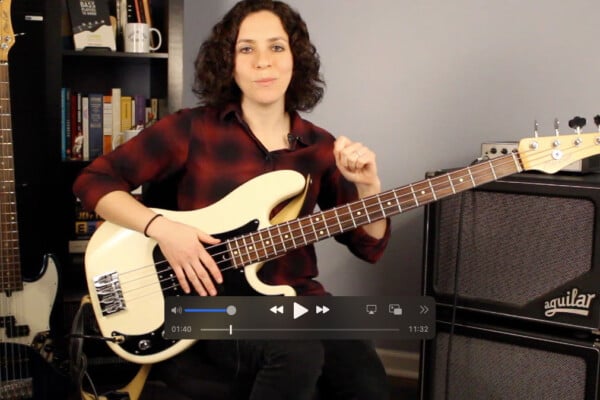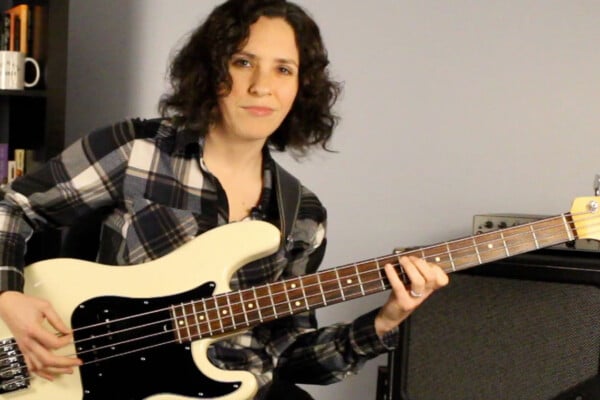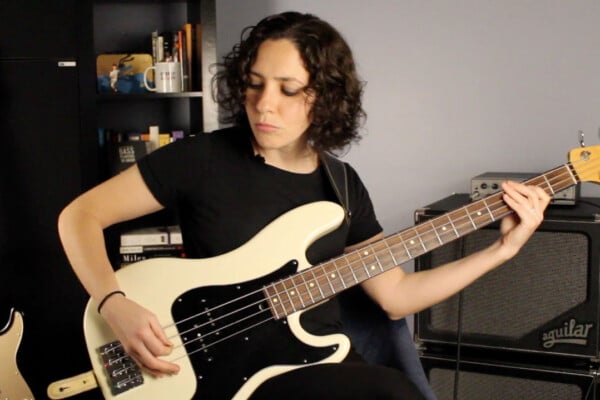Lesson: Master the Fretboard – Part 3
If you’ve been keeping up with this lesson series and having focused practice you should be getting pretty comfortable with the fretboard layout. Remember that the drills in Part 1 and Part 2 should be practiced regularly to get the full benefit. In this lesson we’ll work on something really fun: the blues!
As a note to those who are new to this lesson layout, the fretboard figures are oriented as if you were watching a right-handed bass guitarist play. The top line is the E-string, the bottom line is the A-string. The head would be to the right of the page, the body to the left. The first “bar” on the diagram is the nut, where the “12” is specified it means that the second “bar” is the 12th fret.
Before we get to the blues scale we should discuss an important predecessor: the pentatonic scale. The pentatonic scale is a 5 tone scale made of three whole steps and a minor third. There are no chromatic intervals in this scale so it really gives the feeling of space when you use it. The other great thing about the pentatonic scale is that there are no “avoid” notes, basically everything sounds pretty! The pentatonic scale is made of the 1 2 3 5 6 tones from the major scale. Therefore, in C major we would use C D E G A. Another way to think of the construction of this scale is to use the first 5 tones in the circle of 5ths. Those tones are C G D A E and when they are ordered in the same octave yield C D E G A.

Figure 1: Staff notation of C-major pentatonic
As we have done in previous lessons we can break down the fretboard into the pentatonic scale pattern starting on each note.
![]()




FIGURE 2: Fretboard for each pentatonic form
Combining the patterns on the fretboard give the following comprehensive pattern:

FIGURE 3: Fretboard with all pentatonic forms
You can apply the same practice routines from the Part 1 to gain comfort with this scale form: play through each pattern individually, and then play through all of the patterns together. After you are comfortable with this you can start making small melodies through the combined pattern forms until it becomes second nature. Finally, you need to change keys and practice in other positions. It’s a lot of work, but the payoff makes it worthwhile.
The blues scale is based on the minor pentatonic scale (which happens to be the regular pentatonic scale starting on the 5th note of the pentatonic scale e.g. A minor pentatonic, A C D E G, uses the same notes as C major pentatonic, C D E G A. A is the relative minor of C). See Figure 2 for the 5th pattern. To get the classic blues sound we add the “blue note” passing tone to the scale, a sharp 4 (if we consider the A as the 1). Therefore an A minor pentatonic plus a passing sharp 4 would give: A C D D# E G.

FIGURE 4: Scale of A blues

FIGURE 5: fretboard layout of the blues scale for A
The blues scale will work over a variety of changes, one of the most popular of which is a I-IV-V all arranged as dominant chords. Therefore using the A-blues scale we can play over the progression A7 | D7 | E7. This is not explained well by traditional theory because of the dissonance with the sharp 4, but it sounds so cool!
The blues scale can be used in lots of places, there are defined blues progressions but I think the best indicator is your ear. If it sounds cool go with it.
For practice, use the same drills discussed in the section on the pentatonic scale and add the sharp 4. Once you are familiar with the sound of this scale you’ll be amazed how frequently you hear it in rock solos and other popular songs. Keep your ears open and keep practicing!



